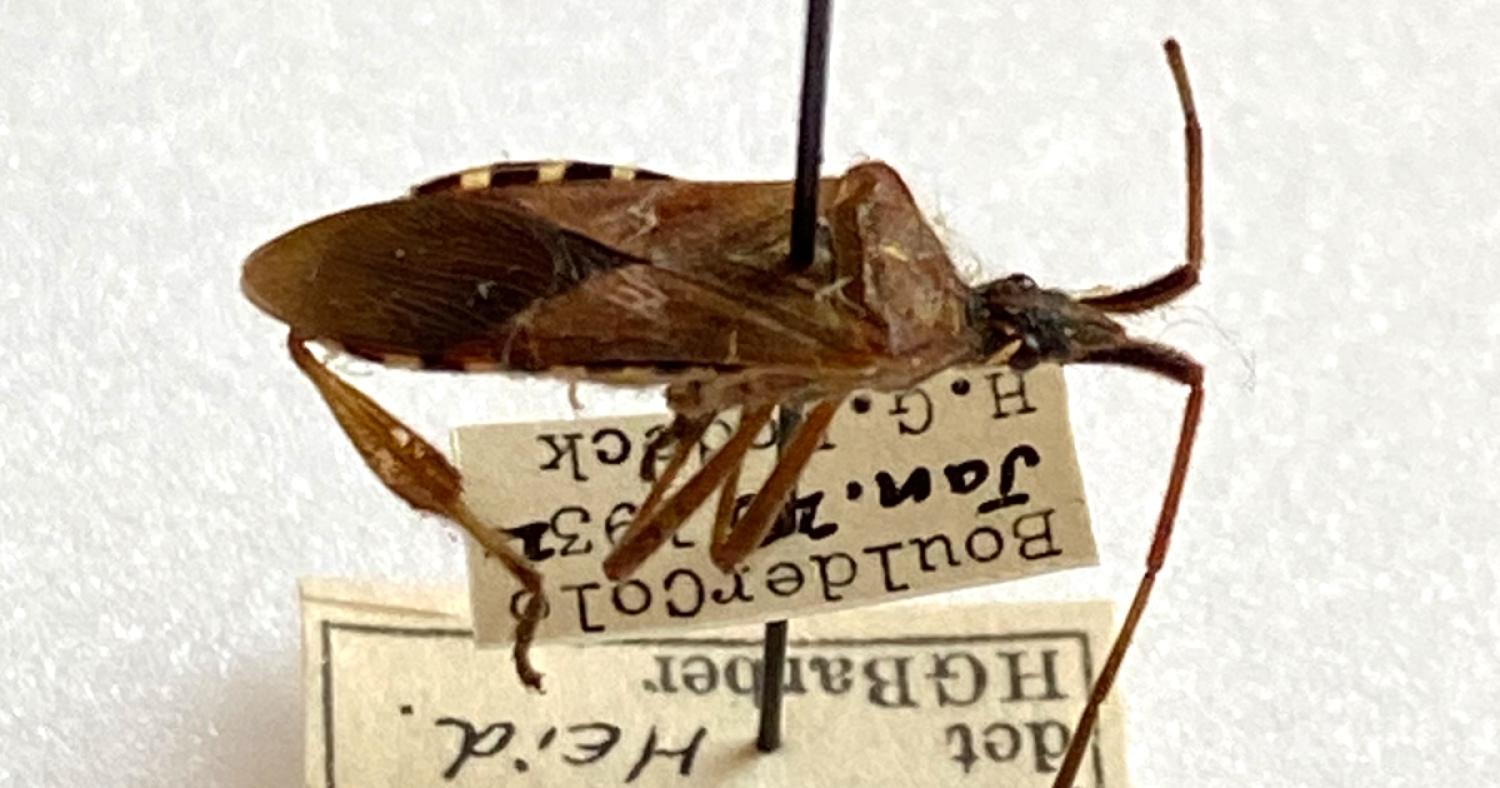The CU Museum is closed. We will be reopening soon.
During this time, collection visits will be available by appointment and other special access requests will be considered on a case-by-case basis.
Please email cumuseum@colorado.edu for more information.
Western Conifer-Seed Bug
The Western Conifer-Seed Bug is a true bug native to the pine forests of western North America that has quickly spread eastward since the 1950s. Pest specialists surmise that these bugs were accidentally introduced to eastern North America through wooden shipping crates on trains or through commercial Christmas trees. After becoming established in eastern North America, they were repeatedly introduced across Europe, Asia, and northern Africa. By the late 1990s, the Western Conifer-Seed Bug was recorded in Northern Italy and has since been found on almost all continents with the exception of Antarctica.
True bugs develop through a process called incomplete metamorphosis, where their body form gradually matures with each molt. After mating in the spring, female Western Conifer-Seed Bugs lay cylindrical eggs on various species of conifer trees, firmly glued to the length the pine needles. The eggs are light brown, and slowly turn to reddish brown as they mature. After about 10 days, the eggs hatch and a juvenile or nymph emerges. The nymphs molt five times, with both the body size and wing pads growing at each molt. After the fifth molt, an adult like the one in the specimen photo emerges.
Both the nymphs and adults feed on developing seeds within pinecones throughout the summer. They stick their needle-like proboscis into the seed, inject a digestive liquid that breaks down the seed’s energy stores and then drink the liquid. This process damages the seed—if there are too many Western Conifer-Seed Bugs in one area it prevents the trees from successfully reproducing. These bugs were first recorded as feeding on Douglas Firs, but have since been recorded on various species of conifers across the planet and wreak havoc outside of their native range.
In the winter, the adults hibernate under tree bark, in bird nests, rodent holes, shipping containers, or in buildings. Bugs who successfully find refuge indoors are commonly spotted throughout the winter months. When temperatures in the spring warm, the bugs awaken from hibernation and feed on the pollen from male conifer trees until the seeds begin to develop.
So, you might be wondering “what good are these energy sucking, stinky (we didn’t even tell you that they smell bad!), tree-killing insect invaders?” We can’t answer that question, but we do encourage you to remember that while it might not be obvious to us, in their native habitat they would be kept in balance through evolutionary processes. They might bug us, but there are no ‘good’ or ‘bad’ bugs.
1 Lesieur, V., Lombaert, E., Guillemaud, T., Courtial, B., Strong, W., Roques, A., & Auger-Rozenberg, M.-A. (2019). The rapid spread of Leptoglossus occidentalis in Europe: A bridgehead invasion. Journal of Pest Science, 92(1), 189–200.
Gullan, P. J., & Cranston, P. S. (2014). The Insects: An Outline of Entomology: Vol. 5. Wiley-Blackwell.
2 Koerber, T. W. (1963). Leptoglossus occidentalis (Hemiptera, Coreidae), a Newly Discovered Pest of Coniferous Seed. Annals of the Entomological Society of America, 56(2), 229–234.
Common name: Western Conifer-Seed Bug
Scientific name: Leptoglossus occidentalis Heidemann (Family: Coridae)
Catalog number: UCMC 0167372
Label data: USA: Boulder County Colorado; 1 January 1931, H.G. Rodeck


